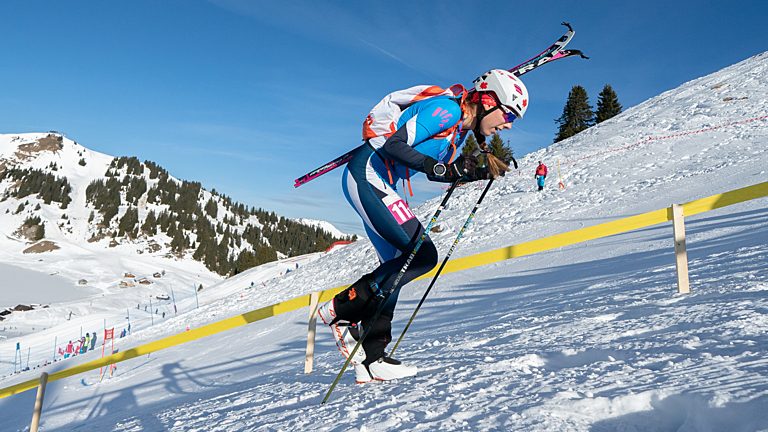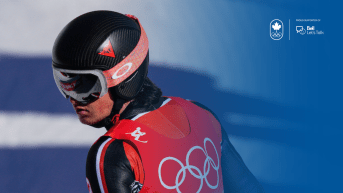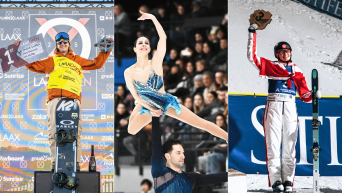Ski Mountaineering 101: What you need to know about the new winter Olympic sport
There’s a new sport on the roster for the Olympic Winter Games—ski mountaineering will make its Olympic debut at Milano Cortina 2026.
Since this sport is likely unfamiliar to a lot of Team Canada fans, we enlisted the help of two of Canada’s top ski mountaineering athletes, Kylee Toth and Matt Ruta, to help explain the ins and outs of this adventurous sport.
Both Toth and Ruta transitioned to ski mountaineering after competing at a high level in other winter sports—for Toth it was short track speed skating, and for Ruta, ski cross. They were both drawn to ski mountaineering thanks to a love of the mountains and a competitive spirit.
One of the first things we learned? Though the official name is ski mountaineering, those in the know shorten that mouthful down to simply “skimo.”
What is skimo?
Perhaps the easiest way to think of skimo is to think of downhill skiing, but then say: what comes down, must go up.
In ski mountaineering, athletes race down a slope on skis, but only after first racing up that slope, using a combination of skiing and mountaineering skills.
The first world championships for ski mountaineering were held in 2002, but the need to travel effectively through mountainous regions stretches back centuries. In Europe, the sport has a longer formal history, emerging from military patrolling in the mountains. Now, ski mountaineering can be seen as a formalized, competitive form of backcountry skiing, which Toth describes as a pastime.
“Skimo is a distillation of backcountry travel and a deep-rooted love for the outdoors,” says Ruta. “And then I think the Olympics is just a further distillation of the racing that we were already doing.”
As skimo continues to be formalized as a sport, it is important to the community that it retains that respect for the outdoors, which spans from the way athletes behave on the course, to how the courses themselves are marked.
“All they do is put seismic pin flags that you follow, so it’s really a leave no trace sport,” Toth says.
What will skimo events look like at Milano Cortina 2026?
There will be two types of ski mountaineering races at Milano Cortina 2026—sprint events for men and women, as well as a mixed team relay. Sprint races can be thought of as having four sections to them, three on the ascent and one on the descent, with transition zones between them, similar to that of a triathlon. Heats are raced with six athletes competing at a time and usually last about three minutes.
“So you’ll leave in skins [attached to the bottom of skis for grip] and travel up with your skis on your feet to a point about a third of the way up the course, and then you take your skis off and put them on your back and run up what’s called a ‘bootpack’,” explains Ruta. “Then two-thirds of the way up the course, you’ll take your skis off your backpack, put them back on your feet and continue skinning to the top, where you’ll take the skins off and transition into downhill mode. And then you ski through a fixed course back down to the start.”
The first athlete to the finish either wins, or progresses to the next round. This shortened version of the sport was created with skimo’s inclusion at the Olympic Games in mind.
“Our original sport is more half marathon distance and over 1000 metres vertical and goes into proper mountainous terrain that necessitates a bootpack,” explains Toth.
So while the terrain in the sprint format may not technically require a bootpack, there was a desire to retain the demonstration of all the traditional mountaineering skills associated with a skimo race.
“As someone who’s been in this sport for a long time, the bootpacks in the sprint are almost humorous to me, because they chainsaw ice steps now, so I always feel like—I have kids—I feel like I’m in Frozen the movie,” says Toth.
But she’s appreciative that the Olympic format has preserved the traditional skills for the shortened sprint.
“Otherwise, we would just run up on skis, rip off our skins, and come down.”
The mixed relay features a slightly larger field of 12 athletes racing at a time, and is longer than the sprint. Each athlete completes loops of the course, tagging their partner in the designated transition zone.
Ruta and Toth have found success as a duo in the mixed relay. The two notched their first top-10 finish on the ISMF World Cup circuit in January 2024, finishing ninth in Boí Taüll, Spain.
What equipment is used in skimo?
The gear for skimo is designed to be very light, as the less extra weight you’re hauling uphill, the faster you’ll likely go. This lightness of the skis, while great for uphill travel, does impact the downhill portion of the race.
“When we go down the gates, we don’t look like alpine skiers because our gear weighs absolutely nothing. Alpine skiers have heavy gear to be gravity fed,” Toth explains. “We’re skiing on a hybrid, kind of like a cross-country ski. It’s extremely challenging to use the same ski for an uphill as well as a steep downhill.”
Skiing uphill is also referred to as “skinning”, as “skins” are attached to the bottom of the skis to provide grip. The name for this gear is derived from the fact that, originally, seal skins were used for this purpose. Nowadays, skins are made of synthetic materials. Skimo racers wear spandex suits that have special pockets for storing skins while they are not in use.
And don’t worry, athletes aren’t running in the equivalent of an alpine ski boot, which sounds like a nightmare. Skimo boots more closely resemble cross-country skiing skate boots, and have the ability to lock in for the descent.
Many rules of skimo are related to gear and are designed with the athlete and environmental safety factors in mind, with carry over from the longer distance version of the sport. Toth would know this well, as the second woman in the world to be officially designated as a skimo referee.
“Putting on my referee hat, the heart of the rules are in safety. Most of them are to ensure that you and the racers around you aren’t being hit by poles and skins,” she explains.
“A good example would be that your skins need to be fully zipped inside your suit when you’re descending. This comes from the longer distances, where they can’t have athletes leaving skins out on a course because it’s littering in the backcountry,” Ruta adds.
The transitioning of gear (taking skins and skis off and on) has rules similar to that of a triathlon.
“Just like you can’t leave a triathlon transition area while still putting your shoe on, it’s similar in skimo,” Ruta says. “In the short disciplines, you might get a 30-second penalty for transitioning outside of the proper area.”
What should new spectators watch out for?
As it’s a race format, skimo shouldn’t be too hard for new spectators to catch on to. That being said, Toth and Ruta offered a couple things to look out for.
“If it’s on TV, it often doesn’t relay the steepness of the slope—both up or down,” says Toth. “Do I think if people could imagine running full gas up a blue/black run at the ski hill, that’s essentially what’s happening for us on very tiny skis.”
“For me, if I’m watching a sprint or I’m watching a relay, I’m really paying attention to the transitions. It sometimes gives you a little bit more insight into the race when you can see who looks really clean on the transitions, who looks flustered, who looks tired,” Ruta says. “And often the attacks in the race are launched straight out of the transition.”
How can Canadian skimo athletes qualify for Milano Cortina 2026?
The field for the first iteration of Olympic ski mountaineering is set to be very small, with only 36 spots available (18 for men, 18 for women). A National Olympic Committee can qualify a maximum of two athletes per gender.
The qualification period for Milano Cortina 2026 spans from November 1, 2024 to December 21, 2025, during which athletes will compete on the ISMF World Cup circuit to accumulate points, which will then determine their placement on the world rankings lists.
“As Canadians, we’re looking forward to going out and just laying it all out there to try and qualify those spots for Canada,” Ruta says. “At least from my perspective, that’s as far as I’m looking—to go for the best possible performance at every World Cup race this coming season, and then see how everything shakes out from there.”
Olympic qualification would be a great achievement for Canada’s fledgling skimo National Sport Organization, which was only formed in 2022.
“Although we are a winter sport nation, this sport is new in Canada relative to other sports,” says Toth. “So I think we’re doing okay considering our slower start. The powerhouse nations [in skimo] are very similar to those in Nordic [events].”
What impact are the Olympic Games likely to have on ski mountaineering in Canada?
The hope is that the Olympic debut of ski mountaineering will provide more global exposure to the sport.
As a parent, Toth sees the sprint format as beneficial in terms of the approachability of the sport for younger athletes and their parents, who may have been wary of some of the safety elements of backcountry travel for youth.
“I think a cool thing about the sprint discipline is that now we can have a club at a ski hill and get eight-year-olds on this gear,” she says. “It makes it accessible from a development perspective.”
Where can I learn more about skimo?
Those interested can check out the Olympic.ca ski mountaineering page, the website of Ski Mountaineering Competition Canada, or that of the sport’s international governing body, the International Ski Mountaineering Federation.



